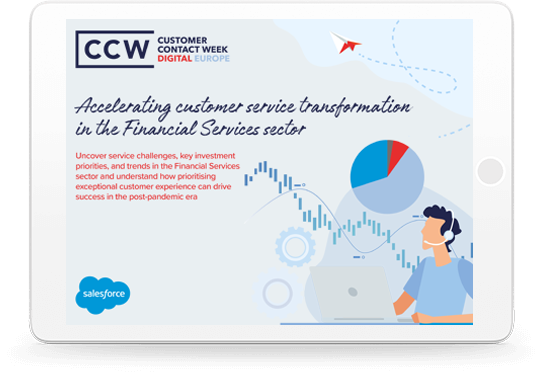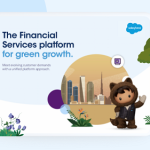Service leaders in Financial Services companies have always been at the sharp end when it comes to delivering customer loyalty and growth. They’re also the ones who want to drive next-generation customer care.
But they face a problem: their world is increasingly complex.
Their organisations are big and unwieldy. The teams they lead are equally as large and now working from anywhere. There’s also an increasing number of channels and, on top of all that, they’re not just hamstrung by outmoded models, but legacy technology too.
Then there are new competitors, never-ending cybercrime and rising customer expectations.
So, the only way service leaders can ever introduce next-generation service across such a complex environment is through AI and automation. And with Salesforce being pre-engineered for Financial Services organisations, moving from the current state to the next generation can be done in a matter of weeks.
Service leaders are talking AI-driven omnichannel
When Salesforce and Customer Contact Week Digital (CCW) recently spoke to service leaders about how they were planning to address such challenges, many pointed to omnichannel operations as an answer.
AI and automation are the backbone of omni-channel customer care and this blog shows five ways they help build next-generation experiences, for customers and agents alike.
1. Creating high-performing teams
Whether in sports, politics, entertainment or business, teams succeed when given the right tools. And for service leaders in Financial Services, AI delivers the means to turn their people into consistent, formidable performers.
How? Well, AI gives leaders real-time visibility into every call, allowing them to analyse each one and identify where specific individuals need additional training. It also highlights which issues take longer to fix and frustrate customers the most. And that allows them to flag these to other parts of the business – such as product or sales – putting everyone in a stronger position to deal with that friction.
It goes without saying that outside of AI, it is physically impossible to monitor these thousands of interactions as they happen or put in place swift resolutions.
2. Skipping steps to get from legacy to next-generation operations quickly
Ask any service leader what gets in their way the most, and legacy technology will be a popular answer. Analogue telephony and a limited number of channels are widespread, as is the need for agents to continually toggle between systems.
These are ubiquitous technologies, baked in over decades. No wonder it can seem a mammoth task just to make the most incremental change, let alone a full pivot to something better.
However, that’s a false perception. Pre-engineered AI allows service leaders to simply skip years of implementation and get to a next-generation state within weeks.
It’s exactly what Salesforce’s Einstein AI can do. Einstein is built into every Salesforce product from the start; there’s no need to think about implementation as it has, in effect, already happened. It means the organisations we work with do not have to undertake years-long programmes to upgrade their operations; the AI is already built into their service, sales, marketing and commerce applications. They can simply move quickly to see exactly what modern customer care delivers. Then, it’s a simple case of embedding AI across their entire operation.
Pre-engineered AI highlights improvements in team morale and customer loyalty almost immediately. It also creates the building block that leaders can build their strategic blueprint on.
3. Helping agents become advisory experts
Working as a contact centre agent is not easy. There are multiple problems to solve every hour, quite often for irritated, or even vulnerable, customers. Before the pandemic, agents would have been surrounded by colleagues whom they could collaborate with, or at least vent during a coffee break.
But now, of course, these teams are dispersed and spread across multiple locations, including home, branch and contact centre. For many Financial Services organisations, hybrid working is not going to change and with attendance in the office as low as morale, it is no wonder that employee retention is low.
AI can act as those missing colleagues (on a professional level at any rate) by providing prompts on what to say or do next – and by looking after the more mundane tasks, such as recording and transcribing calls. It also gives them the space to develop a new diverse skill set, allowing leaders greater leeway when it comes to aligning tasks to individual agents. A fungible workforce (where people share skills) that can solve any customer problem is happier, more productive and ultimately, more loyal.
Suddenly, they are true advisors who are empowered to deliver fast, efficient and empathetic support every time, regardless of the request. Their frustration has been reduced. And they are more likely to be thanked by a happy customer.
4. Not just fixing customer needs, but predicting them
Traditionally, contact centres and the agents that staff them were established to solve a customer’s immediate problem. But by being reactive, they only allow Financial Services organisations to see a single dimension of their customers: the problem they have right there and then.
AI of course is predictive in nature, and that opens up a raft of new opportunities for service teams to add something else to the business.
Imagine a customer who has always paid their standing orders on time, suddenly sees some returned. Or misses a credit card payment for the first time. AI allows teams to reach out empathetically to check that everything is OK, and whether they can help. It can also do so over the channels the customer prefers. Now, let’s imagine that the same customer has just changed jobs and their new salary date has impacted on their standing orders, hence the missed payments. From here, it is straightforward to suggest that the standing order dates be moved back to accommodate the new payday.
5. Building loyalty and sales through customer intimacy
Everyone remembers the company that responded well to an issue or a complaint. Equally, it is easy to recall those businesses that did the opposite.
Issues solved in the right way help build loyalty, often through word of mouth. AI can deliver that loyalty through its ability to help teams ‘swarm’ around an issue. When an agent cannot solve a problem on their own, the technology automatically alerts their manager and any others with the relevant skills and knowledge to help. Together, they can then move to a fix quickly, bringing an end to the days where an irate customer might demand to speak to a manager, as they are already interacting with them.
It can also help service teams turn conversations into opportunities.
Take a customer who is about to retire and wants to swap some direct debits to their partners’ accounts. It may appear a straightforward request to them, but behind the scenes, it will invariably involve input from different teams and systems that cover security, current accounts and more. That’s a lot of complexity for the bank in question. And while it may solve the issue successfully, it has also missed the most important information: its customer is about to embark on a life-changing experience. A moment that they could support and make easier through any number of services and products.
Here, AI alerts the agent (or someone from the sales team) that once the request has been resolved there is a golden opportunity for that ‘magical conversation’. A discussion that is rooted in a positive future state.
On top of all that, AI, automation and self-serve are also the perfect vehicles by which to deal with requests that can be embarrassing, such as debt or cash flow issues. Here it can help point customers towards the right support and the specialist experts with the training and knowledge to help.
Salesforce Einstein powers service leaders
Salesforce Einstein is pre-engineered throughout our Service Cloud. Financial Services organisations including Aegon UK, and Tandem Bank use it as part of their next-generation contact centre operations.
Service Cloud helps Financial Services companies create loyal customers and more satisfied agents for a number of reasons, including:
- AI is built straight into the process flow from the start, which allows them to bring implementation down to a matter of days.
- Trailhead coaching, which delivers dynamic training at a time and in a format that suits agents.
- Integration with Slack, which allows different skills and functions to swarm around a specific customer and their issue.
How Financial Services leaders build next generation customer care
AI and automation give service leaders working in the industry the tools to create amazing customer care. They also allow them to turn their agents into experts, with top-tier support and training, regardless of where they are working from.
The technologies allow leaders to transition quickly into a more high-performing function, and – importantly – maintain that momentum.
Both support the entire service function moving from one that is inherently reactive, to one that is predictive and value-driven. Agents are suddenly not just there to solve everyday problems, but to provide new financial options to customers – especially around those life moments, like a retirement or wedding. Customers, if they wish, can self-serve.
Finally, AI and automation allow the business to open up new opportunities, as a result of great customer experiences. And that changes the internal perception of customer service as a cost centre, into a growth engine.
A chance to go deeper into this topic
The traditional contact centre has reached the end of its useful life span, and that’s reflected in the conversations that CCW had with 45 senior customer experience and customer service leaders within the Financial Services industry. Read more about their findings in the Transform Customer Service in Financial Services Report.
This is the second blog in this series. Blog one discussed how service leaders could create genuine, omnichannel customer service and can be found here
Transforming Customer Service in Financial Services
Using insightful interviews with senior service leaders, discover how customer experience is driving post-pandemic success.

























